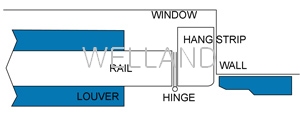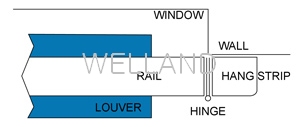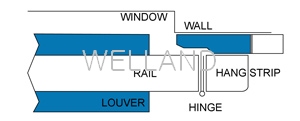| |
| ONLY nylon pins are used to pivot the louvers. Each nylon pin has a 1/32nd shoulder, allowing even spacing between the louver and style. Nylon pins eliminate the problem of shrinking, swelling and wear with movement associated with using wood dowels on the louvers. This allows you to consistently move the louvers easily. The nylon pins have a 1/32nd spacer, providing clearance between louver and style, and prevents wear with operation.To control the tension of the louvers, tension screw placements are normally used, which form an integral part with the nylon pins. Every top and Bottom rail is mortised and tenoned into the vertical stile. |
|
|
| |
|
| |
Shutter Installation Methods |
| |
|
| |
 |
| |
The shutters are attached directly to the jamb of the window. |
| |
|
| |
|
| |
 |
| |
The shutters are attached to a hang strip and the hang strip is attached to the window jamb with screws. You can use hang strips, turned in any direction, depending on your window opening and shutter style. Hang strips may be trimmed as needed. |
| |
|
| |
|
| |
 |
| |
A hang strip on each side of the shutters attaches to the wall. The inside edge of the strip should be slightly beyond the window opening. This installation method is typically used when an inside installation is not possible or the opening is not square. It provides more space behind the shutter for louvers to rotate open. |
| |
|
| |
|
| |
 |
| |
A hang strip on each side of the shutters attaches to a flat portion of the trim. The strip does not have to be located exactly as shown above, but may be located anywhere on the trim so long as there is enough flat surface. It is important to make certain the louvers can be rotated fully open. |
